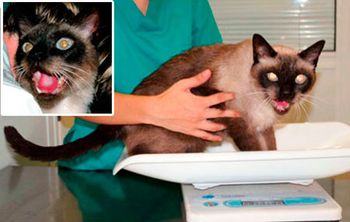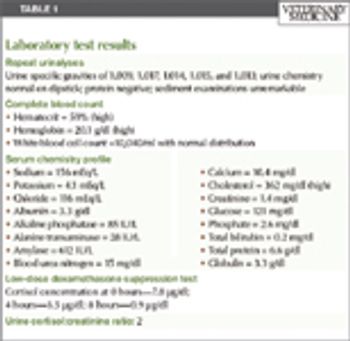
The role of this hormone in diagnosing hyperthyroidism is an area of active research in veterinary medicine.

The role of this hormone in diagnosing hyperthyroidism is an area of active research in veterinary medicine.

Dr. J. Catharine Scott-Moncrieff reveals the keys to insulin control.

What's causing this cat's open-mouth breathing and frantic facial expression?

What is causing this dog's clinical signs?

Dr. David Bruyette helps a reader with a difficult endocrinology case.

Owners think the disease has a greater negative impact on their own lives than on those of their cats.

The goal of this study was to evaluate the effects of lower-dose trilostane treatment.

Diabetes Mellitus (DM) and hyperadrenocorticism (HAC) are common endocrinopathies in dogs that often occur simultaneously in the same patient. Diagnosis and management of concurrent disease may be a challenge to the practitioner since many clinical signs of DM and HAC are similar.

Pathogenesis: Insulin-dependent, non-insulin dependent, and transient

Hypothalamic-pituitary-adrenal (HPA) axis--classic endocrine feedback loop

Thyrotoxicosis is a term used to describe any condition in which there is an excessive amount of circulating thyroid hormone whether from excess production and secretion from an overactive thyroid gland, leakage from a damaged thyroid gland, or from an exogenous source.

Ketone bodies: acetoacetate, beta hydroxybutyrate, acetone

Hyperadrenocorticism is a common endocrinopathy in middle to older aged dogs. Common clinical signs to make the clinician suspicious of hyperadrenocorticism include polyphagia, polyuria/polydipsia, pyoderma, pot bellied appearance, and persistent urinary tract infections.

Canine hypothyroidism is the most commonly diagnosed endocrinopathy in the dog. There is a large incidence of false diagnoses and unnecessary supplementation.

Read the case, look at the photo, and determine the most likely cause of Rosie's insulin resistance.

From the 2011 ACVIM Forum: Is this measure necessary for a good outcome?

From the 2011 ACVIM Forum: Much is stil unknown about this syndrome

Pets with Cushings syndrome suffer from a chronic illness that will be managed throughout the pets life, not cured. This Team Meeting in a Box will help you deliver a successful team-wide approach. (Sponsored by Dechra)

Is the feline diabetic patient every veterinarian's nightmare? Since diabetes mellitus is one of the most common endocrinopathies in cats, it is likely you will face this disease many times in your veterinary career.

When hyperthyroidism was first reported in cats as a disease entity approximately 25 years ago, the majority of cases were advanced. The cats were thin, aggressive, polyuric, polydipsic, polyphagic and had large palpable goiters.

Unfortunately, we don't really know how common clinically relevant pancreatitis really is in our feline patient population. Based on necropsy studies, pancreatic inflammation may be found in anywhere from <1% to 67% of cats, which is obviously an enormous range.

FLUTD refers to a spectrum of diseases that result in pollakiuria, hematuria, stranguria, dysuria and/or periuria in the cat. Common causes of these clinical signs include urolithiasis, urethral plugs and neoplasia (most commonly, transitional cell carcinoma).

Obesity is at epidemic proportions in the United States and worldwide. Despite major public health initiatives spanning several decades, human obesity has reached prevalence rates nearing 40% in some states.

Hypoadrenocorticism (Addison's disease ) is most common in dogs between 2-7 years of age. Breeds predilections include Standard Poodles, West Highland White Terriers, Rottweilers, Great Danes, Leonbergers, Nova Scotia Duck Tolling Retrievers, Portuguese Water Dogs, and Bearded Collies.

Anemia is a common blood work abnormality in many species, including cats. Determining the regenerative nature of the anemia guides the workup of the case. Regenerative anemias suggest blood loss or red cell lysis. Red cell lysis can be due to toxins, infectious agents, neoplasia (as a secondary immune-mediated phenomenon) or primary immune-mediated hemolytic anemia.